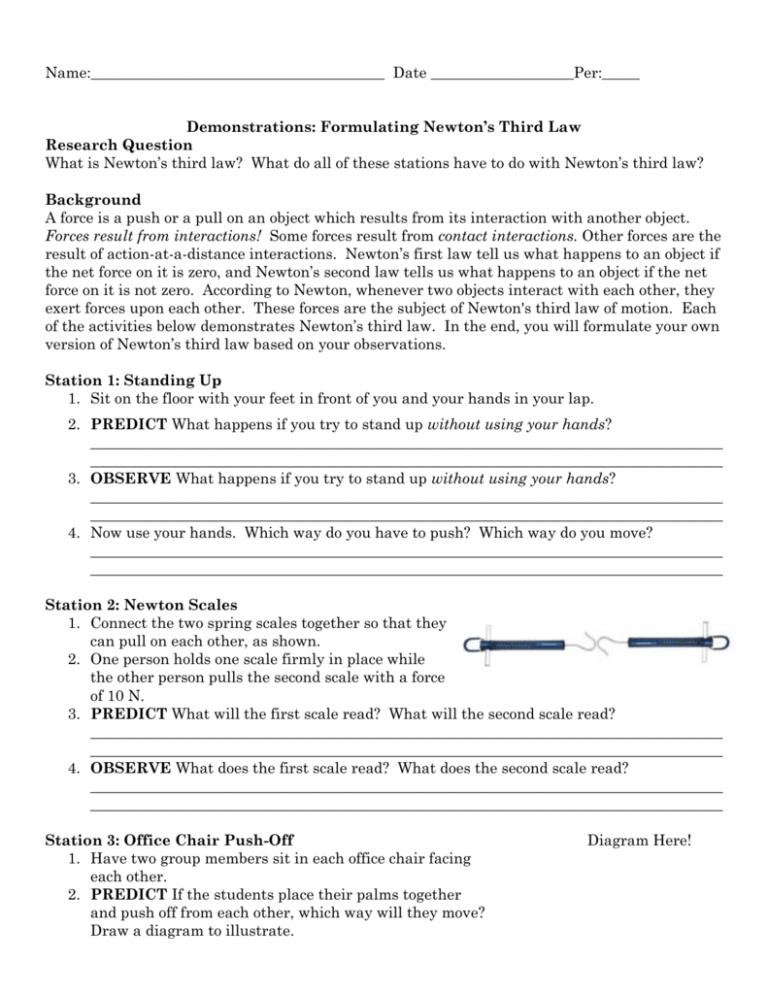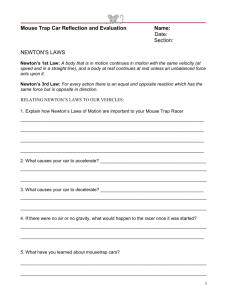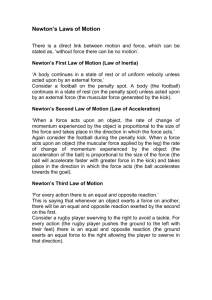Lab-Demonstrations Formulating Newton's 3rd Law of Motion
advertisement

Name:_______________________________________ Date ___________________Per:_____ Demonstrations: Formulating Newton’s Third Law Research Question What is Newton’s third law? What do all of these stations have to do with Newton’s third law? Background A force is a push or a pull on an object which results from its interaction with another object. Forces result from interactions! Some forces result from contact interactions. Other forces are the result of action-at-a-distance interactions. Newton’s first law tell us what happens to an object if the net force on it is zero, and Newton’s second law tells us what happens to an object if the net force on it is not zero. According to Newton, whenever two objects interact with each other, they exert forces upon each other. These forces are the subject of Newton's third law of motion. Each of the activities below demonstrates Newton’s third law. In the end, you will formulate your own version of Newton’s third law based on your observations. Station 1: Standing Up 1. Sit on the floor with your feet in front of you and your hands in your lap. 2. PREDICT What happens if you try to stand up without using your hands? ____________________________________________________________________________________ ____________________________________________________________________________________ 3. OBSERVE What happens if you try to stand up without using your hands? ____________________________________________________________________________________ ____________________________________________________________________________________ 4. Now use your hands. Which way do you have to push? Which way do you move? ____________________________________________________________________________________ ____________________________________________________________________________________ Station 2: Newton Scales 1. Connect the two spring scales together so that they can pull on each other, as shown. 2. One person holds one scale firmly in place while the other person pulls the second scale with a force of 10 N. 3. PREDICT What will the first scale read? What will the second scale read? ____________________________________________________________________________________ ____________________________________________________________________________________ 4. OBSERVE What does the first scale read? What does the second scale read? ____________________________________________________________________________________ ____________________________________________________________________________________ Station 3: Office Chair Push-Off 1. Have two group members sit in each office chair facing each other. 2. PREDICT If the students place their palms together and push off from each other, which way will they move? Draw a diagram to illustrate. Diagram Here! 3. OBSERVE Which way do the students move when they push each other? ____________________________________________________________________________________ ____________________________________________________________________________________ Station 4: Car Wheels 1. Pull the model car forward, and look at the portion of the wheels that directly contacts the table. 2. Which way do the wheels push against the table? 3. Which way does the car move? Draw arrows in the diagram to the right to illustrate. 4. What force allows the car to move forward? _______________________________ Station 5: Bouncing Ball 1. Bounce the ball on the ground. 2. When the ball reaches the ground, it exerts a force on the ground. What makes the ball come back to (nearly) its original height? ____________________________________________________________________________________ ____________________________________________________________________________________ 3. Why do you think the ball doesn’t get all the way back up to its original height? ____________________________________________________________________________________ ____________________________________________________________________________________ Station 6: Balloon Flight 1. Blow up the balloon and pinch the end to hold the air inside. 2. Let go of the balloon. Which way does the air travel out of the balloon? __________________ ____________________________________________________________________________________ ____________________________________________________________________________________ 3. Which way does the balloon travel? ____________________________________________________________________________________ ____________________________________________________________________________________ Conclusions What is your formulation of Newton’s third law? In other words, use the examples from the lab to predict what Newton’s third law says. Write a paragraph that answers the research question.






